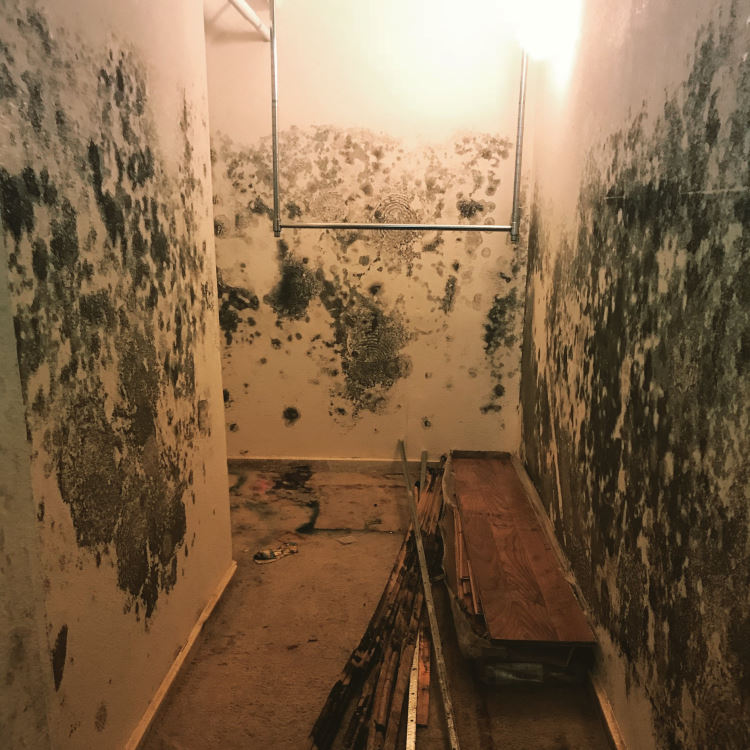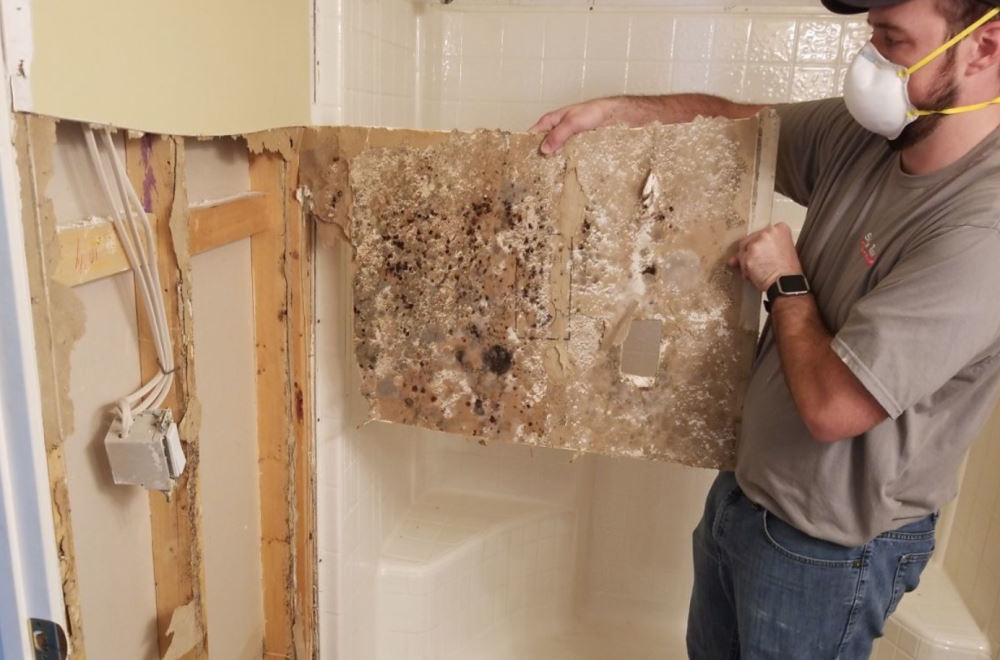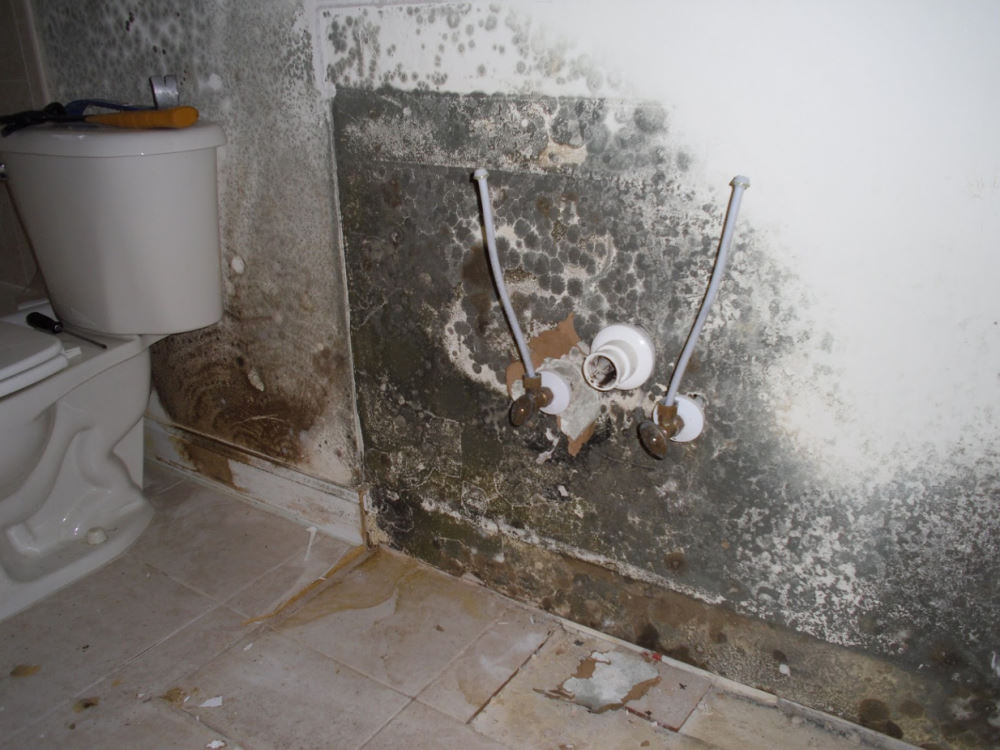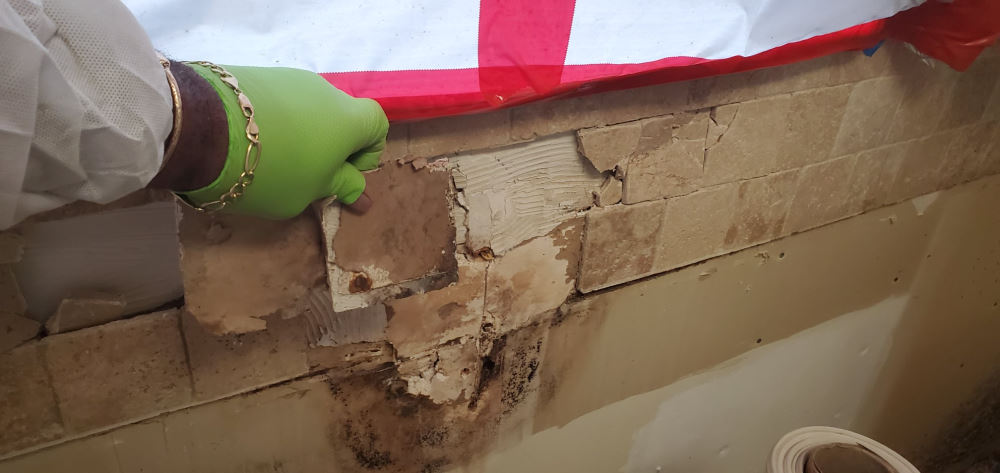Mold Remediation & Removal Services
Professional Mold Damage Restoration for Home and Business Property
With decades of experience inspecting, remediating, and removing mold, STOP Restoration knows how to defeat fungi effectively. Our team is committed to delivering outstanding customer service and quality results. Each of our trained specialists goes above and beyond to help clients fully recover from mold outbreaks, helping homes and businesses function smoothly again. From the moment you call our friendly technicians to the cleanup and repair process, we will take every measure to ensure your home or business is thoroughly restored and safe.

An extreme case of mold requires remediation and removal.
What Is Mold and Why Is it Dangerous?
Mold is a fungus that grows from tiny airborne spores and flourishes in warm, moist conditions. Breaking down and decomposing dead organic matter, mold serves a vital function in our planet’s ecosystem. However, when mold thrives indoors, it can be a severe health concern. Many people are sensitive to mold exposure and can quickly develop allergic or asthmatic reactions. Others can develop symptoms such as a stuffy nose, wheeziness, fever, rash, and itchy eyes. Long-term mold exposure can even trigger upper respiratory tract infections, hypersensitivity pneumonitis, and, in some cases, even fatal health conditions.
What Causes Mold?
We previously mentioned that mold thrives in wet, warm conditions. When indoors, water damage is a leading cause. This is especially true in cases where water damage was not treated by a professional – allowing mold spores to freely disperse.
At STOP Restoration, we offer free mold inspections to both residential and commercial customers. Laboratory testing may be necessary to diagnose the mold type and spore count. After diagnosis, we will design and execute a remediation plan to remove all mold contamination and help prevent future exposure.
The Most Dangerous Types of Mold Found in Your Home
Mold is not always harmful. Nevertheless, certain species of mold pose a serious threat if left untreated. The following are species of toxic mold that commonly grow inside buildings with water damage and moisture:
Stachybotrys
Also known as “black mold,” stachybotrys can cause flu-like symptoms, diarrhea, headaches, memory loss, and severe respiratory damage. While stachybotrys is a health risk for everyone, it is especially dangerous for children. It is important to know that black mold is not always black – it can also be dark grey or green and is usually accompanied by a musty or mildewy odor.
Chaetomium
Like black mold, chaetomium is attracted to moist indoor environments. Chaetomium commonly grows in wet, dark spaces such as underneath drywall, wallpaper, baseboards, and carpets. Exposure to chaetomium spores can lead to mild symptoms such as allergies, red eyes, or shortness of breath. It can also have extreme health consequences, including neurological damage and autoimmune disease.
Aspergillus
Aspergillus mold spores most often grow on food, spices, and stored grains. They can also be carried indoors on shoes and clothing and thrive in carpeted spaces. Aspergillus spores can be health risks for anyone with a compromised immune system. Exposure can cause allergic reactions and lung infections, such as aspergillosis.
Penicillium
Like aspergillus, penicillium is prevalent in many everyday environments. It grows on decaying vegetation/compost, wood, fruit, vegetables, and building materials in water-damaged environments. When trapped indoors, it can disperse into the air and house dust, causing asthmatic reactions, bronchitis, respiratory illnesses, and dangerous infections that can turn fatal.
Fusarium
Fusarium is frequently found in plant debris and soil. It also enjoys moist areas, such as inside drywall and foam insulation, beneath the carpet, and on humidifier pans or HVAC systems. Fusarium species can cause mycotoxicosis if ingested in food colonized by the fungal organism. A serious but rare eye infection known as fusarium keratitis can also arise due to exposure to fusarium spores.
Alternaria
Alternaria rapidly multiplies during the spring and summer months, particularly in moist and humid climates. This mold type is rarely found in building materials but can grow on electric cables, cardboard, and other textiles in your home. If inhaled, Alternaria can cause hay fever, asthma, and allergic reactions in hypersensitive individuals.
Is Mold Affecting Your Family's Health?
When it grows in your home, toxic mold can cause a wide range of health problems. If you or your children already have health conditions, certain species like black mold can be especially dangerous. The most significant health complication that mold creates is respiratory-related. If undetected or unremoved, mold can cause chronic coughing and severe asthmatic attacks. Mold can also affect the pressure in your sinuses, causing headaches and infections. Toxic mold syndrome is perhaps the scariest side-effect of all. This condition involves swelling in the brain, which can lead to confusion, listlessness, and reduced blood flow.

A STOP Restoration professional pulling out a wall slab exposed to mold.
Most Common Areas to Check for Mold in Your Home
Mold loves dense spaces where moisture is easily trapped. It can grow anywhere, including living rooms and bedrooms, but it tends to be found in the bathroom, kitchen, or laundry room.
Bathroom
- In the Shower and Bathtub: Mold can seep into small cracks, grow on shower handles and heads, or spread along shower and bathtub surfaces that do not dry. Run your bathroom fan during and after a shower or bath to reduce moisture.
- In the Sink: Beware of faucet leaks and wet plumbing fixtures. They can get moldy in a hurry.
- In the Toilet: Regularly check under the toilet seat and around the lip of the toilet rim for mold. It can also grow behind and under the toilet itself.
- In the Walls: One of the most dangerous places for mold to grow is in walls, because it can spread undetected for a long time and unknowingly jeopardize your family’s health.
- On the Floor: In bathrooms that lack ventilation, mold spores can even latch onto well-ventilated and open surfaces, such as the floor.

An extreme case of mold in a resident's bathroom.
Kitchen
- The Kitchen Sink: Mold loves wet spaces. Kitchen sinks are especially fertile ground for mold. Check underneath your sink for small leaks to help prevent outbreaks.
- The Fridge: Even with the colder temperatures, your refrigerator can become contaminated with mold spores – especially if you accidentally leave moldy food inside it for a long time.
- The Pantry: Mold can easily grow on dry cereals, bread, and stored grains if the conditions are right. Clean your pantry often and properly seal your food to be proactive.
- The Microwave and Stove: Microwaves and stoves produce heat, which can create condensation and moisture as hot air tries to escape. Inspecting the dark corners for mold and mildew is always wise, and you should make use of kitchen fans to reduce moisture during cooking.
- Other Places Where Food Crumbs Lay: Mold loves to grow in tight spaces. When crumbs are left to rot or decay behind cabinets and pantries, spores will likely propagate quickly.
Bedroom
- On Your Mattress: Mold can even find its way on or underneath a mattress. Given that you likely spend every night sleeping on your bed, the close proximity of such spore colonies is especially hazardous.
- Windows: As warm, indoor air condenses around cold, drafty windows, the glass will begin to sweat with water droplets. This moisture will eventually cause the sills and casings to become wet and develop mold over time.
- AC and Heating Vents: Naturally attracted to damp surfaces and warm areas, mold loves to cling to air-conditioning units, ductwork, and heating vents.
Other Places in the Home You May Find Mold
As a fungal species, mold is very adaptive and capable of surviving practically anywhere there is moisture. If damp for an extended period, mold will happily dwell in attics, refrigerator drip pans, washing machines, chimneys, and cabinets. With our technicians cleaning and treating your water-damaged areas, we can help stop the spread.

A STOP Restoration expert pulling out a tile piece exposed to mold.
How Do I Know When I Should Call About Mold Removal?
When mold growth expands across an area of more than 10 square feet, you should immediately call a mold remediation specialist. Cleaning extensive areas of mold is both dangerous and tricky. Airborne and elusive mold spores are not easy to control or contain.
Our STOP Restoration Mold Removal Experts Remediate Mold By…
Containing the Affected Area to Prevent Cross Contamination
The first step to mold control and prevention is containment. By isolating the contaminated area, we can prevent cross-contamination of unaffected areas. During remediation services, mold will become airborne – there is no way to stop this from happening. What we can do is take every necessary precaution to ensure that spores do not spread to other areas. Our specialists will also set up containment chambers that close-off the hazard zone and simultaneously expedite cleanup by confining dust and debris.
Eliminating the Water or Moisture Source That’s Encouraging Growth
Our professional technicians can implement various strategies to discourage the spread of mold spores. We can fix leaks and water seepage, tend to water-damaged areas, and help you ventilate and dehumidify moist spaces in your home. From preventing moisture that is sneaking into your home through poorly insulated floors and windows to patching and waterproofing any cracks or holes in the walls of your bathroom and kitchen, we have multiple solutions to decrease the damp conditions that mold enjoys.
Removing Visible Mold Colonies and Contaminated Material
When mold colonies appear, it is critical to remove any contaminated material carefully and methodically. It is also important to remove any food, furniture, settled dust, or nearby materials that might become hosts for mold. Our professional specialists know how to get rid of contaminated materials in an effective and safe manner. By sealing off surrounding materials, we will prevent spread. In fact, the entire transport route will be protected to stop airborne mold spores from finding a new home in your building.
Mold Removal Before and After Photos
Check out some amazing photos that show just how thorough and effective our mold removal procedures are:

View Mold Remediation and Removal Before & After Gallery
How Much Does It Cost for Mold Removal & Remediation?
Our team is available 24 hours a day to deal with mold emergencies. Prioritizing your health and peace of mind, our certified technicians will happily conduct a free inspection of the affected area and customize a plan of action that clearly outlines our services and all related costs. When it comes to mold remediation, the costs are determined by the scope and area of the infestation. Regardless of the job size, we offer competitive and fair prices without cutting corners, ensuring mold is properly eliminated from your business or home.
Can I Remove Mold Myself?
Removing mold can be hazardous and complicated. If remediation is performed without proper equipment or protocol, you may become sick. Even worse, the mold may end up all over your building. With goggles, protective gear, masks, and best-in-class tools, our remediation specialists will inspect your attic, crawlspace, ductwork, carpet, and walls to securely remove any mold colonies.
Why It's Important to Hire a Professional Mold Removal & Remediation Specialist
Avoid the hassle and health risks of treating mold infestations yourself! Instead, call our professional technicians to provide a complete mold assessment and treatment plan. Our specialists go beyond the surface of the problem–locating the full extent of spread and eliminating the culpable sources of moisture. There is much more at stake than cleaning an affected area. Dealing with the humidity, removing mold, and sealing off leaks are essential to ensure mold spores don’t latch onto new surfaces.
- We Are Trained and Certified: At STOP Restoration, our specialists are licensed, trained, experienced, and certified to handle mold remediation projects. By relying on professionals who know the proper methodologies and who expertly monitor airflow to contain spores, you can put an end to your property’s current mold infestation. Our team will also provide concrete tips and suggestions for how to keep mold away in the future.
- We Have the Best Protective Equipment Available: When it comes to mold remediation, quality PPE is essential. We show up with gloves, goggles/eye protection, and respirators that range from the N-95 to full-face air-purifying respirators equipped with filter cartridges. These respirators provide inhalation and exhalation valves that filter the air and remove mold particles.
- We Have the Right Tools to Get the Job Done: Our mold removal technicians rely on antimicrobial chemicals, dehumidifiers, high efficiency HEPA filtration machines, and sealants/encapsulants that respectively clean, dry, and seal off problem areas.
Enjoy Peace of Mind of a Job Done Right by Hiring STOP Restoration for Mold Removal & Remediation!
Mold is a dangerous health threat that needs to be taken care of with haste. By hiring STOP Restoration, you will receive the expertise you deserve. With our superior mold remediation and removal services, your home or business will be restored in no time. Enjoy the peace of mind of a job done right!
Contact STOP Restoration at (844) 500-4775for mold remediation and removal today!













[1].2502200941255.png)



